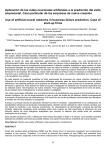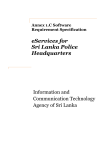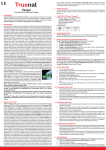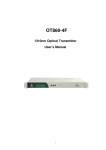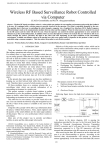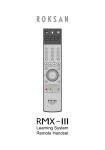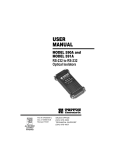Download Data Acquisition System for Hydro Power Plant Operation and
Transcript
256 Proceedings of the International Conference on Information and Automation, December 15-18, 2005, Colombo, Sri Lanka. Data Acquisition System for Hydro Power Plant Operation and Maintenance Automation Kamalanath Samarakoon* *Mahaweli Hydro Power Complex Ceylon Electricity Board, 40/20 Ampitiya Road, Kandy, Sri Lanka 20000 Email: [email protected] Telephone: (94) 81-2499199 Abstract— In the hydropower plant operation and maintenance, a large number of process variables are analyzed prior to taking decisions. This necessitates automated data acquisition systems since the manual methods of data collection cannot provide the necessary resolution and accuracy. A vast majority of hydro power plants in Sri Lanka do not posses such facilities. It is not feasible to overhaul control systems only to introduce data acquisition features. On the other hand, off-the-shelf data acquisition systems have limited capabilities and are also very expensive if it is tailor made. In this paper we report successful design, development and implementation of a data acquisition (DAQ) system for the hydro power plants of the public power utility of Sri Lanka. I. H INTRODUCTION ydropower industry is one of the industries which involves a large number of plants and equipment. A large number of process variables and status information is required for plant operation management and maintenance automation. This data should be further processed to take management decisions in operation and reliability centered maintenance management activities [1]. As the first step towards the automation of such activities, it is necessary to automate the acquisition of process variables. Sri Lankan hydro power system comprises of power plants built with different technologies prevailing at the design and construction period, thus ranging from relay logic controls to state-of-the-art PLC systems. At a majority of power stations, the alarms and trip status are recorded manually every minute and meter readings are recorded every hour. The one minute reading accuracy of events is not sufficient because a machine could be tripped within a few seconds and hence sequence of events in chronological order can not be recorded at all. Manually recorded analogue measurements are kept in archives for reference only, because the manual interpretation is an exhaustive process. The accuracy of meter readings is also not sufficient, as the point of change is not recorded and hence these cannot be related to the other associated changes of states. The state-of-the-art technologies employ multiple systems for data acquisition and automation purposes and hence require separate systems for process monitoring, history recording, fault recording and controlling purposes etc. Each system comprises of hierarchically arranged sub systems and those subsystems usually have more than one processing unit. These systems are very expensive and require complete replacement or major rehabilitation of the existing control systems of hydro power plants. On the other hand, off-the-shelf standalone systems that can be installed in existing plants without overhauling the control systems usually have specific functionalities such as Digital Fault Recording (DFR) etc. Such systems are not capable of acquiring a large number of process variables continuously at a slow sampling rate. They usually capture a window of state changes before and after a fault. As a developing country, it is not cost effective to replace or rehabilitate all the plants with modern control systems with in-built data acquisition features, but it is still required to collect the process parameters on line for fault analysis, history recording, and trend analysis for effective operation and maintenance management of the power plants. The unavailability of suitable low cost DAQ solution for our needs and the availability of commercial PC systems which have very high processing power and are of low cost urged us to explore the possibility of developing such a system in-house. The developed system comprises of commercially available industrial computers and interfacing hardware, in-house developed signal conditioning and monitoring hardware and in-house developed software. The implemented systems usually comprise of about 800 digital inputs and about 100 analogue inputs per station. The time accuracy of digital inputs is 1ms and that of analogue inputs can be varied between 1 second to 1 minute. This accuracy is quite sufficient for data acquisition and controlling purposes. This system has extra digital and analogue channels and can be easily upgraded. Therefore any number of additional inputs can be connected to investigate 257 Proceedings of the International Conference on Information and Automation, December 15-18, 2005, Colombo, Sri Lanka. intermittent faults - a type of faults where diagnosis is extremely difficult. The paper also reports the problems encountered and solutions given in the harsh environment encountered in power plants with high magnetic interference, variable contact bounces, different control voltages and inadvertent human interference etc. This system is presently installed in all the power plants of Mahaweli Hydro Power Complex, of Ceylon Electricity Board. [2], [3] circuits. Each card can accommodate 48 channels. While the circuitry remains the same, the components of each card can be varied depending on the input signal. By varying the components four different types of digital isolator cards were fabricated for the input DC voltages of 220V, 48V, 24V and 5V. In isolator card shown in Fig. 2, R0 is for current limiting and R and C makes a noise filter and D is the reverse voltage protection for the optocoupler. The optocoupler isolates the field input from the PC interfacing cards and the computer. The RC low pass filter of analogue filter card shown in Fig.3 suppresses the power frequency magnetic interference, II. HARDWARE FOR DIGITAL AND ANALOGUE INPUTS DAQ Isolater (48 Channels) DAQ Isolater (48 Channels) DAQ Isolater DAQ Isolater (48 Channels) (48 Channels) OMEGA CIO DIO 192 (192 Channels) Shielded Ribbon Cable Industrial PC OMEGA CIO DAS 48 (48 Channels) Shielded Ribbon Cable DAQ Filter (48 Channels) V V +Vcc Analogue IP Transducer A Rec Iin=0-5,10,20mA Analogue Analogue IP Card Analogue IP(12 Card Analogue Ch) IP Card (12 Ch) IP Card (12 Ch) (12 Ch) Digital Digital IP Card Digital IP Card (12Ch) IP Digital Card (12Ch) IP Card (12Ch) (12Ch) +Vcc Digital IP Vin=220,48,24,5 Vdc, -Vcc Fig1. DAQ System Block Diagram The system comprises of two types of off-the-shelf electronic PC interfacing cards, two types of in-house developed signal conditioning cards and two types of input protection cards. One set is for digital inputs and the other set is for analogue inputs and they are connected as shown in Fig.1. The digital card is capable of capturing 192 digital signals [4] and the analogue card is capable of capturing 24 or 48 analogue inputs depending on the configuration [5]. Number of digital and analogue cards varies from station to station according to the requirement. The Isolator Card for optical isolation of digital inputs and the Filter Card for filtering magnetic interference at power frequency were developed as signal conditioning 5V Rh DAQIsolator Card R0 OMEGADIO192 2.2k (pull up) Digital IP Card To PC R C D Fig. 2. Digital input configuration which is a common occurrence in power plants. Also R acts as the current to voltage converter so that PC-interface card gets a voltage input. Filter cards were developed for input signals of 20mA, 10mA and 5mA. 258 Proceedings of the International Conference on Information and Automation, December 15-18, 2005, Colombo, Sri Lanka. III. HARDWARE FOR WATCHDOG – MONITOR CARD Rh OMEGADAS48 DAQFilter Card R0 V Transducer AnalogueIP Card R A/D/Converter C ToPC Fig. 3. Analogue input configuration Analogue and digital input cards were developed to ensure the safety of the existing circuits of power station with 12 channels per card. The digital input card which is connected immediately after the connecting point comprises of a high power resistor that acts as a current limiter even in the short circuit condition and also as a voltage divider so that the output voltage is low enough to be handled by the next signal conditioning circuit. The analogue input card has a zener diode, which prevents the current transducer from being open circuited. In such an event, the zener diode will break down and original circuit of the power plant will not be disturbed. Due to this, the interference made to the existing system is minimal and a malfunction of the DAQ system will not disturb any control function of the plant. DAQ monitor card monitors the healthy operation of the DAQ system and sends an interrupt signals to DAQ monitor software to re-launch the stopped software or warm boot the whole operating system. If both attempts fail, it will alarm the operators. The circuit has three similar sections to monitor the state of the DAQ System as shown in Fig. 4. Each section comprises of two re-triggerable mono-stable configurations. One is waiting for at least one input pulse (to give output high) and other is looking for the absence of an input pulse for a given period of time to give the output high. The output of the next stage is disabled until it receives at least one pulse from the previous stage. The first section is monitoring a pulse train coming from computer through an output channel of the PC-interface card. The scanning loop of the DAQCapture software sends a pulse at each loop to indicate that the capturing is going on. When first pulse is received from the digital card, the state of the monitoring card changes to the Booted state. The mono-stable is at an unstable state and is not allowed to reach a stable state, as it is re-triggered by every subsequent pulse. In the absence of the pulse, the first stage waits for T1 seconds and send an output pulse to re-launch the software. Restart Pulse Serial Port Driver RS232 Port Reboot Pulse Alarm Signal Alarm Interface To Annunciation System Booted Stage 3 Alarm Module Reboot Pulse System Enabled Stage 2 Rebbot Module Booted Booted Restart Pulse System Enabled Stage 1 Restart Module System Enabled Input Pulse Power On Reset Module Fig 4. DAQ Monitor block diagram The PC-interface cads and signal conditioning cards are kept at close proximity to each other and they are connected using screened cables so that the magnetic interference is kept minimal. The same pulse triggers the second mono-stable. That signal changes the system state to Restarted state and waits T2 sec before giving the output. If it receives the Booted signal before giving the output, then it changes to the normal state. The output of the second stage will change the third stage to Rebooted state where it waits T3 sec before alarming the operation staff through normal power plant annunciation system. During that period it looks for "Booted" signal and 259 Proceedings of the International Conference on Information and Automation, December 15-18, 2005, Colombo, Sri Lanka. if it receives this, the system changes to normal state without alarming. The waiting times T1, T2, T3 are preset considering the time taken for each operation. tests, 13ms was used as a typical value of bounce for most of the relays and later modified by considering the number of bounces registered in the event list. The re-launch, warm boot and cold boot signals are given to DAQ PC through serial port to the monitor software, which monitors the healthy operation of the system. IV. SOFTWARE Three essential software applications run continuously and simultaneously for the operation of the DAQ system. The DAQ capture program runs in a continuous loop, polling all the input ports and recording any change of the input. The information of state changes and periodically captured analogue data are stored in the memory (RAM). When the inputs are free from state changes for a predefined period, it quickly flushes the data in RAM memory to the magnetic memory (hard disk) as a random access file. The DAQConverter, which is looking at the hard disk for new data files, will convert the data in this file and write it into a database. The third software is the DAQMonitor, which acts as a watchdog to monitor the status of the DAQ system and restart the software or restart the PC or alarm the operators when required. Additional software - the DAQMMI is used to display the captured information in both text form and graphical form. The DAQConfig is used to configure the ports and inputs. The DAQIPCheck is a test program, which displays the status of every port online. This program is used during the system configuration. V. DESIGN DETAILS Most of the power plant control systems comprise of relay logic and these relays have contact bounces for a period of about 10 –100ms. Typical characteristics taken from a high speed data recorder is shown in Fig 5. Normal annunciation systems have inbuilt time delay of about 50ms, to alarm operator only for persistent alarms and also have latching circuits to hold the alarm. But in this development our intention was to use this as a diagnostic tool and it is necessary to get all the information without filtering so that 1ms glitch is also important. When 1ms changes are taken as inputs, the relay bounces also appear in the event list which makes it crowded. In order to circumvent this problem, an algorithm was developed to record any change (even that of 1ms duration) and also to suppress bounces which occur within a predefined period. The period could be set for each digital input considering the contact bounce of the relay. This feature proved to be very effective during the operation where the relay bounce become prolonged when the relay becomes older and sluggish. It can be taken as an early warning of a failing relay. After several field Fig 5. Typical relay bounce characteristics obtained from a high speed data recorder Instead of single software for capturing and conversion, two different software were developed to optimize the speed. The capturing software is optimized for timing hence only essential information is transferred to the temporary random access file. This information of digital inputs include the port number, present and past port values (8 or 4 bits) system time and millisecond counter reading of MS Windows operating system. The analogue information includes time, port number and binary value of the analogue reading. This software is optimized for reading digital values over that of analogue. Only one analogue value is read after scanning all the digital inputs. This is done only if the total scanning time is less than a specified time. This ensures the correct time stamping of digital inputs at the expense of accuracy of analogue readings. Normally analogue readings are stored every 1-minute (this can be set to one second also) and all the intermediate analogue values read at every digital scan, and are averaged. Therefore analogue readings also give very accurate reading for a given period of one minute. The DAQConverter software reads the information of digital inputs and decides the present state, input channel number and also calculate the time accurate to milliseconds as described below. The binary value corresponding to analogue input is used to calculate the input value based on the transducer characteristics and scaling factors. The collected data values are written to databases for the use of other applications. The computer system clock is accurate to 1 second and is prone to drift with time. But millisecond accuracy is required for the above system. Hence the internal millisecond counter of Windows operating system is used for deriving the time accurate to millisecond. When the DAQcapture program is started, the initial date and time is recorded with the millisecond counter value. The counter 260 Proceedings of the International Conference on Information and Automation, December 15-18, 2005, Colombo, Sri Lanka. value is taken at the instance of the change of second and it is considered as the initial millisecond counter corresponding to zero millisecond of the initial second. Subsequent times are calculated using the initial date, time and initial millisecond counter and present millisecond counter values. The necessary steps have been taken to Saving Time (mS) 1200 1000 DB Open in Advance 800 DB Open and Write 600 Memory Array Sequential File 400 Random Access File 200 ODBC 0 0 500 1000 1500 -200 Number of Readings Fig. 6 Comparison of time taken for saving of temporary files with the number of readings including ODBC Saving Time (mS) 60 50 40 DB Open in Advance DB Open and Write 30 Memory Array 20 Sequential File 10 Random Access File 0 0 500 1000 1500 -10 Number of Readings Fig. 7 Comparison of time taken for saving of temporary files with the number of readings excluding ODBC introduce GPS synchronized clocks for time synchronizing of DAQ systems as readings of different stations are to be analyzed on the same time base for station wide failures. The use of random access files for temporary data transfer between the DAQCapture and DAQConverter showed faster operation than any of the other methods as shown in the Fig.6 and Fig. 7, except a software array that uses computer RAM. VI. CONCLUSION The introduction of the DAQ systems to the power stations has proved the worthiness of the system from the first date of operation. Large number of faults which went undetected before, were corrected. It helped to pin point the origin of some of the island wide power failures. Also it has given indications prior to failure and also has helped to identify bad contactors and wire connections. The captured data is available in databases and a number of applications have been developed to work on this data for operation management and reliability centered maintenance management [6]. The low cost solution itself saved about 25 million Rupees to the utility. Improvement of operations management could save billions of Rupees to the utility and to Sri Lanka. The data acquisition is a preliminary requirement of any engineering application especially when it is necessary to acquire real world information. On the other hand such equipment is very expensive, if they are to be imported. The above application shows that we can develop a low cost system at any scale ranging from a few digital and analogue inputs to a large number of inputs as in the above case. This can save a huge amount of money to the institution and to the nation. Most of the projects cannot take off the ground due to the unavailability of funds for such data acquisition systems. In most of the cases we deploy systems that do not employ the latest microprocessors and are purchased at an exorbitant cost. It may be true that such equipment is well tested and proven and posses a lot of facilities. But these facilities may have been introduced to be competitive in the market (even if they are not required by us) at an additional cost. Most of our requirements are not mission critical and also do not involve fast varying data hence our own DAQ system could be easily made only by using a normal PC and a few low cost DAQ PC-interfacing cards. As engineers and technologist, it is our duty to change the mind set of our decision makers and also of ourselves to develop our own technology – may be crude at the beginning – to reach the distant goals of sustainable development. This is very important at this juncture where we are facing financial crisis as institutions and a foreign currency crisis as a country. ACKNOWLEDGEMENT Author would like to thank Mr. F.K. Mohideen and Mr. W.R.A. Perera (DGMs of Mahaweli Hydro Power Complex) for their initiative in this project, Mr. A.K. Samarasinghe (Chief Engineer – Electrical and Instrumentation , Mahaweli Hydro Power Complex) for his continuous support and guidance in design and implementation. Author also thanks all the Chief Engineers and Engineers (Instrumentation & Development) of power 261 Proceedings of the International Conference on Information and Automation, December 15-18, 2005, Colombo, Sri Lanka. stations and their technical staff for carrying out all the station modifications and field wiring. REFERENCES [1] [2] [3] [4] [5] [6] Advid Becker, Herb Falk, “Standards-based approach integrates utility applications,” IEEE Computer application in power, October 2000 pp. 14-20 Samarakoon, S.M.K.B. “An Inexpensive Single Microprocessor Based Data Acquisition Card for Information Transfer.” Proceedings of the Engineering Jubilee Congress ‘ENGINEERING BEYOND 2000’, Faculty of Engineering, University of Peradeniya, Vol1, June 2000, pp 21-24. Sri Lanka Samarakoon, S.M.K.B. “Development of Data Acquisition System for Fault and Efficiency Monitoring of Hydro Power Stations.” Reference Manual Rev2.0, 2003 January Omega Engineering “User’s Manual,” CIO-DIO 192 User’s Manual, 1997 Omega Engineering “User’s Manual,” CIO-DAS 48-PGA User’s Manual, Rev 2, April 1995 Douglas Proudfoot, Dave Taylor, “How to turn a substation to database server” IEEE Computer application in power, April 1999, pp. 29-35








